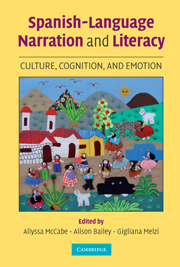Book contents
- Frontmatter
- Contents
- List of Contributors
- Preface
- Acknowledgments
- 1 Introduction
- PART ONE PARENT–CHILD NARRATIVES
- PART TWO DEVELOPING INDEPENDENT NARRATION
- 7 The Intersection of Language and Culture Among Mexican-Heritage Children 3 to 7 Years Old
- 8 Beyond Chronicity: Evaluation and Temporality in Spanish-Speaking Children's Personal Narratives
- 9 Narrative Stance in Venezuelan Children's Stories
- 10 Mestizaje: Afro-Caribbean and Indigenous Costa Rican Children's Narratives and Links with Other Traditions
- PART THREE NARRATIVE LINKS TO LITERACY AND OTHER SCHOOL ACHIEVEMENTS
- Author Index
- Subject Index
- References
9 - Narrative Stance in Venezuelan Children's Stories
Published online by Cambridge University Press: 05 June 2012
- Frontmatter
- Contents
- List of Contributors
- Preface
- Acknowledgments
- 1 Introduction
- PART ONE PARENT–CHILD NARRATIVES
- PART TWO DEVELOPING INDEPENDENT NARRATION
- 7 The Intersection of Language and Culture Among Mexican-Heritage Children 3 to 7 Years Old
- 8 Beyond Chronicity: Evaluation and Temporality in Spanish-Speaking Children's Personal Narratives
- 9 Narrative Stance in Venezuelan Children's Stories
- 10 Mestizaje: Afro-Caribbean and Indigenous Costa Rican Children's Narratives and Links with Other Traditions
- PART THREE NARRATIVE LINKS TO LITERACY AND OTHER SCHOOL ACHIEVEMENTS
- Author Index
- Subject Index
- References
Summary
Key words: narrative genre, evaluative language, discourse perspective
ABSTRACT
This chapter focuses on Venezuelan children's use of evaluative language in the construction of narrative stance. Two types of stories, personal and fictional, are compared in terms of the strategies used in narrative perspective building. Certain aspects of evaluative language (e.g., use of modal expressions and reported speech) are examined in detail to determine how children combine the voice of self and other in narrative production. The main purpose is to determine the ways in which narrative type, children's age, gender, and social class affect narrative production.
For this study, 444 (personal and fictional) stories were elicited in semistructured interviews conducted in 6 (public and private) schools with 113 monolingual native speakers of Venezuelan Spanish between the ages of 6 and 11. Of these children, 52 were girls and 61 were boys; 54 were from a low-socio-economic status (SES) and 59 were from a high-SES background. The results show that children adjust to genre requirements because the same child can use different strategies in personal and fictional narratives. The findings also suggest that certain grammatical forms (e.g., modal expressions) are still developing in this age group. Moreover, children's sociocultural background has a considerable effect in fictional storytelling, but the effect of SES is negligible in the production of personal narratives. This in-depth analysis of school-age children's oral narrative abilities can shed light on the difficulties they may face when they start acquiring productive and receptive skills related to written narratives.
- Type
- Chapter
- Information
- Spanish-Language Narration and LiteracyCulture, Cognition, and Emotion, pp. 213 - 236Publisher: Cambridge University PressPrint publication year: 2008
References
- 6
- Cited by



